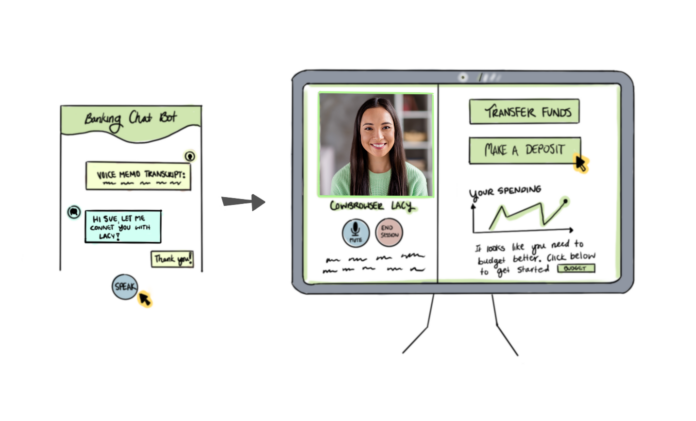In reading articles about up-and-coming technology, such as AI chat bots and voice activated controls, I realized there is a great opportunity to utilize technology to make digital banking more accessible and personable. What I have found from secondary research about older adults and banking is they enjoy in-person banking for its human interaction, security, ability for banking processes to be explained, and so on. I learned that many older adults are open to utilizing virtual technology, they just don’t know how and are worried about making mistakes. Also, I have found how important it is to make virtual experiences inclusive for people with disabilities or sensory issues. In combining all these insights, I think a great idea for digital banking would be to utilize AI and Co-browsing functionalities to personalize digital banking and better include older adults in the process.
Specifically, I would create an AI chat on the home page of the digital banking site or app. In this chat, users can choose to voice their questions/comments or type them, along with either reading the responses or playing them out loud. When they ask the chat questions, the chat can provide secure yet unique banking answers, explanations, and personal financial information. For instance, the AI conversation will work similarly to chat GPT, where a unique response comes from whatever is entered – no more automated messages, and more of a personalized conversation. The user can ask the chat to transfer funds or tell them about their balances and suggested spending/budgeting ideas based on their financial information. It is sort of like Siri, but specifically for banking needs. Users can name their chat bot and say “Hey ___ please transfer $200 from my savings to my checking.” Next, to incorporate human interaction and emotion, users can request to work with a human co-browser. They will be paired with a co-browser who they can see and speak with onscreen. The co-browser has access to the user’s screen and can take them through different functions of the digital bank, both teaching them and completing activities for them. They can help explain the analyzed data that users see on screen, like spending suggestions and give their personal input, so users feel more confident about their banking decisions. Between the use of an AI chat bot and co-browsing, older adults will be able to have more conversation in their digital banking experience, along with the opportunity to learn how to digitally bank from the comfort of their own home. It will allow them to independently manage their finances for longer, without having to worry about physically getting to a bank branch or making mistakes online.
Analysis: I recognize that this idea will take a lot of user interface trial and error. I will need to figure out how to make it accessible on the front end, so users do not struggle accessing the chat or co-browsing functions. I will also need to look further into the security of allowing AI chat bots access to people’s financial information, and how I can make older adults more comfortable communicating with an AI chat. I understand that many companies utilize AI chat bots and Co-browsing, but I see that this conjecture offers a different perspective by allowing for a more inclusive user interface, so it is more accessible for older adults or people with sensory disabilities. In addition, this AI chat can complete banking actions for the user instead of just answering questions. Finally, there is a question of cost and availability of co-browsers – I hope we can prevent bank tellers from losing their jobs by allowing them to transition to a virtual co-browsing bank teller service.
Although many questions are still left unanswered, I look forward to expanding upon the usage of AI, co-browsing, and voice activated controls in the banking experience.




